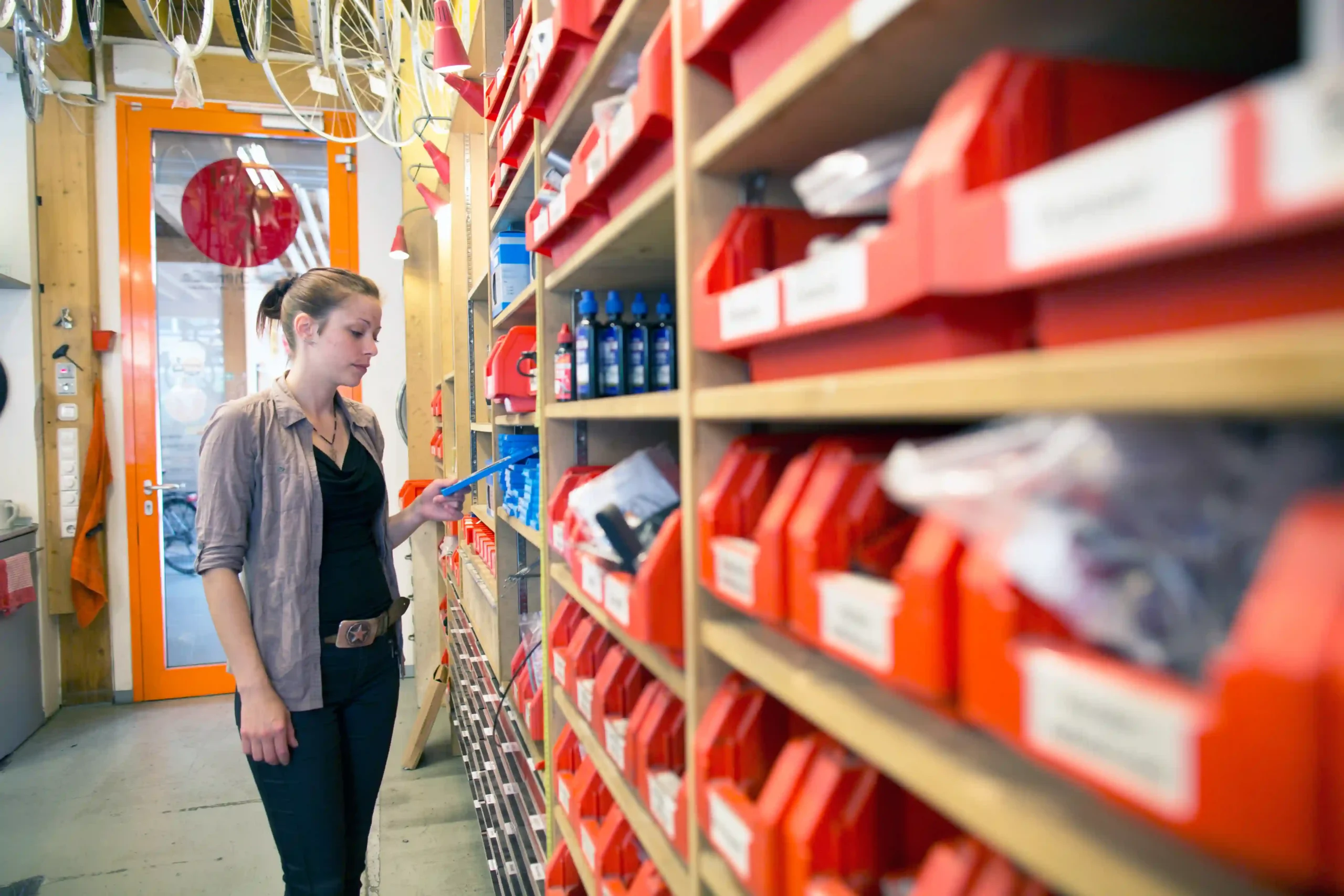To put it simply, inventory management is the process of keeping track of what products or materials a business has on hand, what needs to be ordered, what’s currently on the shelves, and what’s been sold. But for us here at Tri-Link FTZ, with over three decades in third-party logistics and Foreign Trade Zone operations, inventory management goes far beyond just counting boxes.
It’s the heartbeat of operational efficiency. Inventory touches every part of your business—from how you manage your warehouse layout to the way you handle supplier relationships.
It includes the raw materials coming into your facilities, products in progress, and finished goods waiting to ship. If something’s off in your inventory system, you’ll feel it fast: stockouts, overordering, delays, or worse—angry customers.
That’s why we treat inventory management as a strategic pillar of every client’s supply chain design.

When businesses ask us, “Why should I care so much about inventory?” my answer is always the same: inventory management is what separates scalable businesses from chaotic ones. Whether you’re a global distributor or a startup running fulfillment from a storage unit, managing inventory properly protects your margins and reputation.
Let me give you an example from a client we onboarded last year. They were struggling with constant backorders and overstock on seasonal products.
After auditing their system, we found that their demand forecasting was off and their safety stock thresholds hadn’t been adjusted in over a year. With some automation and hands-on planning, we helped reduce their holding costs by 18% and their customer complaints dropped by over 40%.
That’s the power of proper inventory control. Inventory, in essence, is money sitting on a shelf.
If it’s not moving or not accounted for, it becomes a liability rather than an asset. It also ties directly into cash flow.
Too much money tied up in excess stock means less flexibility to invest elsewhere. Too little stock means missed opportunities.
Balance is everything—and good inventory management makes that balance possible. Read more here.
After 35 years in the logistics field, I’ve seen businesses of all sizes benefit from having the right inventory system in place. There are several key components we recommend focusing on, whether you’re using enterprise software or just starting with spreadsheets.
First, inventory tracking is essential. This means knowing where every unit is, from receiving dock to storage to outbound shipments.
Technologies like barcodes and RFID have helped immensely here, but it starts with having good internal processes. At Tri-Link, we ensure that every item entering our FTZ warehouse is logged and tagged, providing full visibility for our clients at any time.
Second, you need order management tools. These help automate purchase orders, monitor restock thresholds, and keep your team from scrambling during a stockout.
Next comes warehouse storage optimization—if your shelves aren’t organized and space isn’t used efficiently, even great software won’t help. We’ve built custom storage layouts for clients that have cut travel time by 30% inside the warehouse.
Another component is fulfillment integration—you want your inventory system to speak with your order management and shipping processes. At Tri-Link FTZ, we connect directly with client storefronts or ERPs so their sales data feeds into inventory levels automatically.
Lastly, reporting and analytics drive smarter decisions. Whether you’re measuring turnover ratios or cycle counts, data helps forecast demand and reduce errors.
We create custom dashboards for our clients to track these metrics weekly, not quarterly, so they can pivot faster.
Inventory isn’t just one single thing sitting in a warehouse—it comes in several forms, each with its own purpose and strategy. At Tri-Link FTZ, we regularly help businesses manage all four major types of inventory, and knowing how to handle each can drastically improve your operations.
The first type is raw materials. These are the components used to make finished products.
For a furniture company, it might be wood and screws; for a cosmetics brand, it could be essential oils and containers. Managing raw material inventory well means making sure you’re never short on key ingredients but also not overstocking items that will take up space and tie up funds.
Next comes work-in-progress inventory. This includes anything that’s in the production phase but not yet finished.
One of our clients runs a hybrid manufacturing-distribution model out of our FTZ, and we help them track these semi-finished goods in real time. This stage can be tricky since timelines shift quickly, but visibility here avoids unnecessary delays.
Then we have finished goods inventory, which is what most people think of when they hear “inventory.” These are items ready to be sold and shipped.
You want to keep just enough on hand to fulfill customer demand without overstocking. With tools like predictive analytics and real-time dashboards, we help businesses walk this fine line every day.
There’s also MRO inventory—Maintenance, Repair, and Operations supplies. These aren’t sold but are essential to daily operations, like gloves, cleaning supplies, or replacement parts.
Ignoring MRO can grind your workflow to a halt. That’s why we recommend tracking it in the same system as your finished goods.
Lastly, there’s returns inventory, or what some call reverse logistics. These are items sent back by customers, often needing inspection, restocking, or disposal.
Managing returns efficiently improves customer satisfaction and reduces waste. At Tri-Link, we’ve created a returns flow that integrates seamlessly with our inventory systems so our clients always have updated data. Read more here.

Over the years, I’ve worked with businesses using nearly every inventory method under the sun. Each has pros and cons, and the right choice depends on your industry, product type, and how you fulfill orders.
The most common question I get is, “Which method should I use?” So let’s break them down.
FIFO (First-In, First-Out) is one of the simplest and most popular strategies. It means the oldest stock gets sold first.
It’s ideal for items with expiration dates, like food or pharmaceuticals, and helps reduce spoilage and obsolescence. We recommend FIFO to almost every business with perishable or seasonal items.
LIFO (Last-In, First-Out), on the other hand, assumes that the most recently added stock is sold first. While not as common, some industries use this for financial reporting benefits, especially in high-inflation environments.
Just be mindful that LIFO isn’t allowed under some international accounting standards. Just-In-Time (JIT) is all about lean inventory—ordering only what you need, when you need it.
We’ve helped several ecommerce brands implement JIT systems using automated reorder points. It minimizes storage costs but requires tight coordination with suppliers.
A single delay can ripple through your whole operation. EOQ (Economic Order Quantity) uses a formula to determine the ideal order size that balances ordering and holding costs.
It’s very data-driven and helps reduce overordering or underordering. This is especially useful in manufacturing and wholesale distribution.
Lastly, ABC analysis separates inventory into three categories: A (high-value, low-volume), B (moderate value and volume), and C (low-value, high-volume).
This helps prioritize what you monitor most closely. At Tri-Link, we often apply ABC analysis to our clients’ SKUs and assign different tracking rules for each category, which saves time and money.
We’ve seen it all—businesses with great products that lose customers because their inventory systems fail. Mismanaged inventory can quietly destroy a company’s finances and reputation.
I remember a client who was overspending on overnight shipping every week just to make up for out-of-stock products. They thought it was a customer service win, but it was crushing their margins.
The first major risk is stockouts—when you run out of product. This leads to missed sales, frustrated customers, and lost trust.
If it happens too often, customers will go somewhere else permanently. The flip side is overstocking.
Too much inventory sitting idle racks up storage costs, ties up cash, and increases the risk of obsolescence. We had one client with thousands of outdated electronics they couldn’t sell.
We helped them liquidate and redesign their inventory flow, saving over $80K annually. Inventory shrinkage is another hidden cost—loss from theft, miscounts, or damage.
Without proper systems, it’s hard to spot. That’s why we always suggest cycle counting and regular audits. Then there’s the administrative burden.
Poor systems create bottlenecks, confusion, and constant fire drills. Teams waste time chasing orders, fixing errors, or dealing with irate customers.
And when your team is busy solving preventable problems, they’re not focused on growth. Finally, it damages your brand reputation.
Late deliveries, out-of-stock items, and returns erode customer trust. Consistency is key, and inventory management is what gives you that control.
Not all inventory tools are created equal. Over the years, we’ve tested dozens and helped clients select and implement systems that fit their needs and budgets.
The right software should integrate with your existing operations and be simple enough for your team to use daily. At a minimum, a good Inventory Management System (IMS) should track stock levels in real-time, trigger reorder alerts, and support barcode or RFID scanning.
Systems like Zoho Inventory, Cin7, and NetSuite are popular for growing businesses. For larger operations, ERP platforms like SAP or Oracle NetSuite offer deeper integration but require more setup.
We’ve also seen success with cloud-based tools that allow remote access and mobile scanning, especially for businesses with multiple warehouses or remote staff. AI and automation are now being baked into some of these platforms, offering forecasting and anomaly detection.
If you’re just starting out, even a well-built Excel or Google Sheet can do the job temporarily. But as your business grows, so does the need for robust tracking.
At Tri-Link FTZ, we help our clients choose scalable tools that won’t just work today but grow with them for years to come.

If you’re a small business owner, inventory management might feel overwhelming. I get it — you’re already wearing five hats.
But trust me, starting early with even a basic system will save you a world of headaches down the road. At Tri-Link FTZ, we work with many startups and small operations, and here’s the approach we often guide them through.
Start with an inventory audit. Know exactly what you have, where it is, and how it moves.
Even if you’re using pen and paper or spreadsheets, getting visibility is the first step. Once you know your stock levels and turnover patterns, you can start making better decisions.
From there, set reorder points based on real sales and lead time data. This helps prevent last-minute rush orders or running out of your bestsellers.
We advise small businesses to avoid relying on gut instinct and instead base reorder triggers on actual usage and supplier timelines. You’ll also want to organize your stock by category, SKU, or location.
If it takes five minutes to find something, your system is broken. Efficient shelving and labeling reduce errors and speed up picking and packing, especially during busy seasons.
Training your team — even if it’s just you and one other person — is critical. Everyone involved in your operations should follow the same system for receiving, logging, and shipping products.
Consistency creates accuracy, and accuracy builds trust with your customers. Finally, explore lightweight inventory software tools that can grow with you.
Many have free tiers or trial versions. The earlier you build digital habits, the smoother your scaling journey will be.
We’ve helped several ecommerce businesses go from garage storage to fully integrated cloud-based warehouses — and it all started with simple, repeatable processes.
Once your system is running, it’s time to measure how well it’s working. There are a few key performance indicators (KPIs) we use at Tri-Link FTZ for our clients — and ourselves — to stay sharp and make improvements.
First up is the inventory turnover ratio. This tells you how many times you’ve sold and replaced inventory during a period.
A higher ratio means your products are moving, while a low one might signal overstocking or slow-moving items. Then there’s days sales of inventory (DSI), which measures how long your current inventory will last based on your average daily sales.
The lower the number, the more efficiently you’re cycling through stock. You also want to watch your stockout rate — how often you run out of products that are in demand. If this happens too often, you’re losing sales and possibly customers.
On the flip side, carrying costs help you track how much you’re spending just to hold on to inventory — including rent, insurance, and depreciation. Lastly, track your order accuracy rate.
Are customers receiving what they actually ordered? Mistakes not only cost you money in returns and reshipping but also hurt your reputation.
We’ve found that even a 2% error rate can snowball into thousands of dollars in losses over time. Tracking these KPIs consistently helps you spot patterns, course-correct quickly, and build a stronger business.
Let me give you a few snapshots of how inventory management has transformed businesses we work with. One of our clients, a mid-sized cosmetics brand, came to us with major inventory issues — stockouts during product launches, mismatched packaging, and confusion across three different warehouse locations.
After implementing an RFID-based tracking system and consolidating their reporting dashboards, they reduced shipping delays by 56% and increased launch success rates dramatically. Another case: a global parts distributor was storing massive amounts of low-moving SKUs, tying up hundreds of thousands in cash.
We helped them implement ABC analysis and cycle counting, then restructured their storage zones based on product velocity. Within six months, they freed up 22% of their warehouse space and shifted those resources to higher-margin inventory.
And who could forget 2020? One of our clients — a health supplies wholesaler — saw an 800% spike in demand overnight. Because they had already worked with us to automate their reorder points and integrate real-time supplier data, they were one of the few businesses in their niche that didn’t run out of stock.
Their market share jumped, and they’ve maintained that growth ever since. These stories aren’t unicorn moments — they’re the result of putting inventory systems in place before the chaos hits.
Preparation really does create opportunity.

Looking ahead, inventory management is going to look a lot smarter. At Tri-Link FTZ, we’re already using AI-powered forecasting tools that help predict demand based on seasonality, promotions, and even weather trends.
This helps our clients fine-tune their order volumes with better accuracy than ever before. Internet of Things (IoT) sensors are another game-changer.
These allow businesses to track not just location, but also temperature, humidity, and movement. That’s huge for industries like food, pharmaceuticals, or high-end electronics where conditions impact product integrity.
We’re also watching blockchain become a serious player in supply chain transparency. It offers a secure, shared ledger where multiple parties can access verified data about inventory status.
For FTZ operations where customs compliance and traceability are critical, this can reduce friction and fraud. Even quantum computing is making early waves in supply chain optimization.
We’re not there yet, but imagine being able to simulate thousands of demand scenarios in seconds to find the most profitable stocking strategy. That’s where we’re heading.
And for small and mid-sized businesses, the future is connected systems. Inventory, accounting, sales, and fulfillment all talking to each other in real time through integrations.
You’ll no longer need to chase down spreadsheets or hope someone updated the count correctly. The systems will do it for you — and flag issues before they become emergencies.
When you really think about it, inventory management is not just an operational task. It’s a strategic advantage.
It affects your profit margins, your customer satisfaction, your ability to scale, and your resilience during crises. And after 35 years running a third-party logistics and FTZ business, I can confidently say: the businesses that win are the ones that master their inventory.
You don’t need a giant warehouse or a million-dollar software package to start. What you need is a plan, consistency, and the right tools for your current stage of growth.
The rest will follow. If you’re not sure where to begin, or your current system is letting you down, feel free to reach out to us at Tri-Link FTZ.
We’ve helped businesses of every size — from ecommerce startups to global manufacturers — turn their inventory from a headache into a strategic weapon. Because at the end of the day, when your inventory flows, everything else falls into place.
Share this article
We have other resources available upon request as well as one-on-one support and personalized answers, just like our services.
Simply contact us anytime and we’ll get back to you to answer your questions and provide meaningful answers that show you how Tri-Link supports your logistics, reduces costs, and accelerates efficiency.
Tri-Link delivers exceptional FTZ and 3PL services tailored to your global trade needs.
Our solutions combine innovation, quality, and efficiency to exceed your expectations and meet your specific requirements.